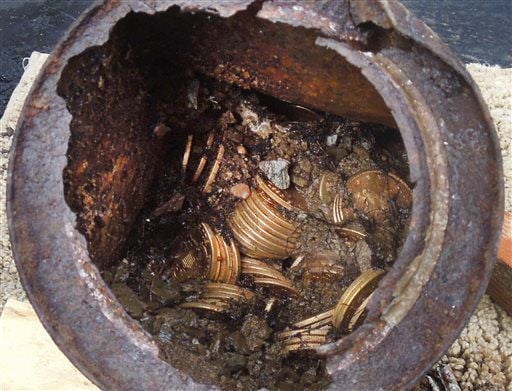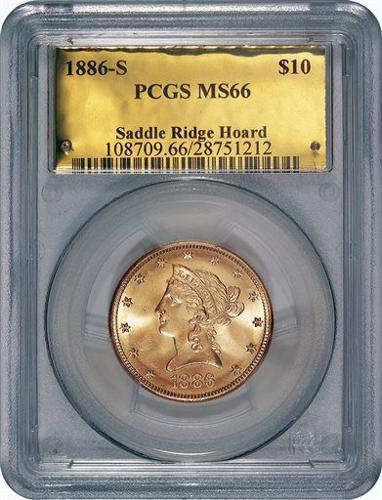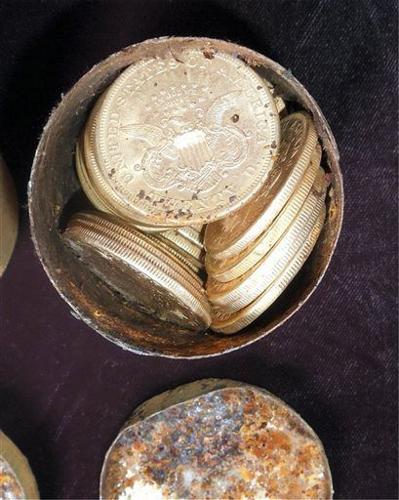Una pareja de California que paseaba a un perro encuentra 10 millones de dólares en raras monedas de oro



LOS ÁNGELES – Una pareja del norte de California que paseaba a su perro en su propiedad se topó con una bonanza moderna: 10 millones de dólares en raras monedas de oro en perfecto estado enterradas a la sombra de un viejo árbol.
Casi todas las 1.427 monedas, que datan de 1847 a 1894, se encuentran en perfecto estado y sin circular, dijo David Hall, cofundador del Professional Coin Grading Service de Santa Ana, que recientemente las autenticó. Aunque el valor nominal de las piezas de oro sólo asciende a unos 27.000 dólares, algunas de ellas son tan raras que los expertos en monedas dicen que podrían alcanzar casi un millón de dólares cada una.
“No me gusta decir “una vez en la vida” para nada, pero nunca se tiene la oportunidad de manejar este tipo de material, un tesoro como este”, dijo el veterano numismático Don Kagin, quien representa los buscadores. “Es como si hubieran encontrado la olla de oro al final del arco iris”.
Kagin, cuya familia ha estado en el negocio de las monedas raras durante 81 años, dijo poco sobre la pareja más allá de que son marido y mujer, son de mediana edad y han vivido durante varios años en la propiedad rural en Gold Country de California. donde se encontraron las monedas. No tienen idea de quién los puso allí, dijo.
The pair are choosing to remain anonymous, Kagin said, in part to avoid a renewed gold rush to their property by modern-day prospectors armed with metal detectors.
They also don’t want to be treated any differently, said David McCarthy, chief numismatist for Kagin Inc. of Tiburon.
“Their concern was this would change the way everyone else would look at them, and they’re pretty happy with the lifestyle they have today,” he said.
They plan to put most of the coins up for sale through Amazon while holding onto a few keepsakes. They’ll use the money to pay off bills and quietly donate to local charities, Kagin said.
Before they sell them, they are loaning some to the American Numismatic Association for its National Money Show, which opens Thursday in Atlanta.
What makes their find particularly valuable, McCarthy said, is that almost all of the coins are in near-perfect condition. That means that whoever put them into the ground likely socked them away as soon as they were put into circulation.
Because paper money was illegal in California until the 1870s, he added, it’s extremely rare to find any coins from before that of such high quality.
Sign up for free: Springs AM Update Your morning rundown of the latest news from Colorado Springs and around the country overnight and the stories to follow throughout the day delivered to your inbox each evening. View all of our newsletters. Success! Thank you for subscribing to our newsletter. View all of our newsletters.
“It wasn’t really until the 1880s that you start seeing coins struck in California that were kept in real high grades of preservation,” he said.
The coins, in $5, $10 and $20 denominations, were stored more or less in chronological order in six cans, McCarthy said, with the 1840s and 1850s pieces going into one can until it was filed, then new coins going into the next one and the next one after that. The dates and the method indicated that whoever put them there was using the ground as their personal bank and that they weren’t swooped up all at once in a robbery.
Although most of the coins were minted in San Francisco, one $5 gold piece came from as far away as Georgia.
Kagin and McCarthy would say little about the couple’s property or its ownership history, other than it’s located in Gold Country, a sprawling, picturesque and still lightly populated section of north-central California that extends east of Sacramento to the Nevada line, running through the hills and valleys of the Sierra Nevada mountain range.
The discovery of gold at Sutter’s Mill, about 50 miles northeast of Sacramento, set off the California Gold Rush of 1848.
The coins had been buried by a path the couple had walked for years. On the day they found them last spring, the woman had bent over to examine an old rusty can that erosion had caused to pop slightly out of the ground.
“Don’t be above bending over to check on a rusty can,” Kagin said she told him.
Estaban ubicados en una sección de la propiedad que la pareja apodó Saddle Ridge, y Kagin llama al hallazgo Saddle Ridge Hoard. Cree que podría ser el mayor descubrimiento de este tipo en la historia de Estados Unidos.
Uno de los mayores hallazgos anteriores de monedas de oro fue el de un millón de dólares descubierto por trabajadores de la construcción en Jackson, Tennessee, en 1985. Se encontraron más de 400.000 dólares de plata en la casa de un hombre de Reno, Nevada, que murió en 1974 y fue Posteriormente se vendió intacto por 7,3 millones de dólares.
En la década de 1980 se recuperaron monedas y lingotes de oro de los restos del SS Centroamérica, cuyo valor se estimaba en 130 millones de dólares. Pero los historiadores sabían aproximadamente dónde estaba ese oro porque el barco se hundió frente a la costa de Carolina del Norte durante un huracán en 1857.



